Welcome to a new issue of the Journal of Runic Studies, the premier Malkioni publication for studies into the nature of Glorantha. If you haven’t subscribed yet, please consult with the spirit bound to the appropriate electronic page.
God Learner Sorcery
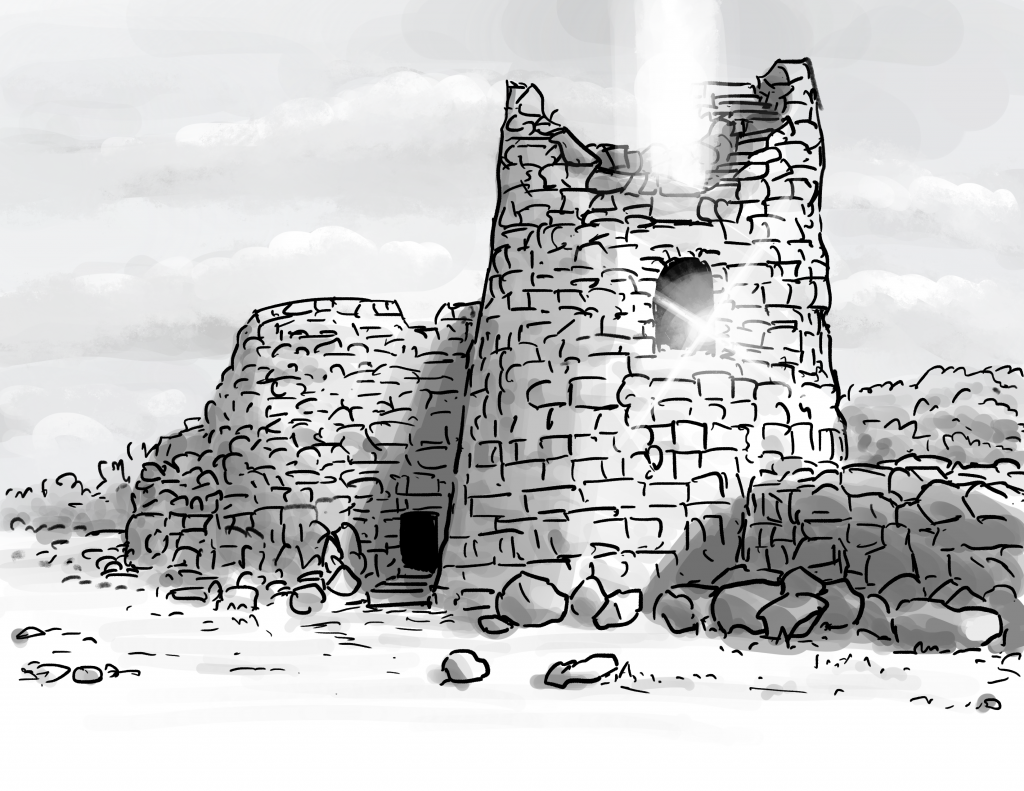
We are a little late releasing Episode 4 of the podcast, and for this we apologize! Well, actually no, we don’t apologize. We are the Zzaburi, we answer to no one, not even the Gods!
However, we do have to answer to our spouses and the chaotic obligations of the tumultuous time known as “back-to-school”. Oh well. The audio editing is almost done, and the episode should be playing in your ear in the next couple days.
Chaosium News

Here are this week’s Chaosium news!
The White Bull Season Two Concludes
The Chaosium “house campaign” gamemastered by Jeff Richard concludes its second season as the party returns to Prax by way of Caravan Alley and Biggle Stone, where the Adventurers (re)visit the Morokanths. They make a stop at the Paps, and finally head up to New Pavis where their patron, Argrath, still resides. He might be interested in all the news, loot, and severed dragon heads they bring with them… or maybe not.
After D&D: RuneQuest!
Chaosium’s Jeff Richard is the inaugural guest for Eliza Lambert’s After D&D YouTube channel, which will interview designers of games that D&D players might try when they want a break from rolling D20s.
In the interview Jeff goes over what makes RuneQuest great, what are the similarities and differences between RuneQuest and D&D, and so on.
One seemingly small difference (not mentioned in the video) is that RuneQuest uses percentile dice with which you want to roll low. For the longest time I thought dice and rolls didn’t matter much (my early gaming years mix Cyberpunk’s D10, Vampire’s dice pools, Call of Cthulhu’s D100, and many more), but more recently I found a whole section of the internet that is apparently genuinely confused by the idea of rolling low instead of high… go figure.
Jonstown Compendium

The Jonstown Compendium is Chaosium’s community content program for all Gloranthan games, hosted on DriveThruRPG. Disclaimer: all the relevant links are affiliate links that hopefully will let us cover some of the hosting and maintenance costs for the website and podcast! Thanks for using them!
Black Spear
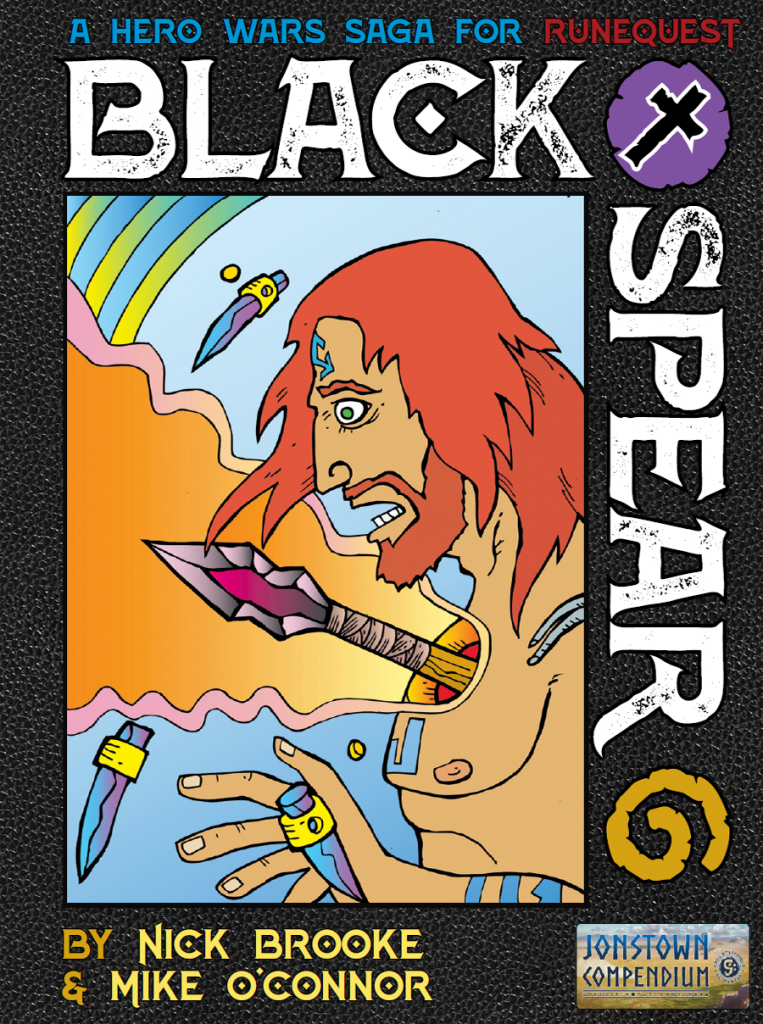
Nick Brooke’s marketing machine was already in first gear, but now I expect it to go into overdrive, with the release of his long promised and awaited Black Spear campaign!
The 180 pages of content will take you through the early Hero Wars, following Nick’s Duel at Dangerford, which is recommended but not required to play as a prequel. As always with a Nick Brooke book, expect songs and poetry, and lots and lots of wackiness. Disco balls and Muppet Show wackiness. It may help to drink some alcohol before picking up the PDF.
Jallupel Goodwind
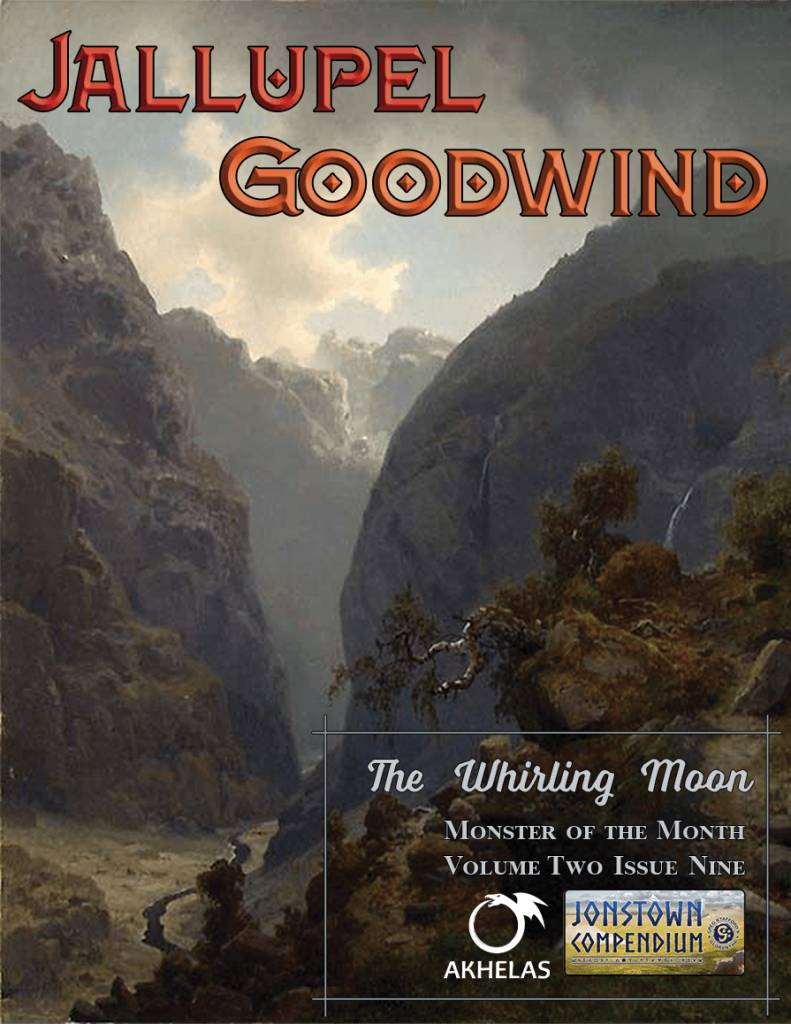
The new Monster of the Month features a collaboration between two of the most unstoppable authors of the Jonstown Compendium: Austin Conrad and Diana Probst! They have a short adventure for us with a really cool main protagonist: the mingled ghost of a Lunar Hero and a Wind Lord, who died while battling each other. And, as is usual for the series, a bunch of smaller goodies!
Jeff’s Notes

Jeff Richard, the current mastermind on everything Gloranthan at Chaosium, is often posting notes and thoughts on the RuneQuest Facebook group. Here’s our curated list from the past week. A partial archive of these sources is compiled on the Well of Daliath.
Temples and Godly Presence
Jeff tells us about the difference between most Lunar temples and most other Dragon Pass temples:
Almost all of the Lunar temples outside of the Lunar Heartlands are unusual in that they do not have a ready connection with the history or mythological landscape of the area. When Dragon Pass was resettled, the settlers knew that Orlanth, Ernalda, the Lightbringers, Yelmalio, etc. all “resided there”. In many cases, temples were built on the old temples from before Dragonkill. Boldhome was built in a valley sacred to the Orlanth cult since First Age. Clearwine Earth Temple had been an active place of Earth worship since the Second Age at least, and the Shaker Temple has been the home of Maran Gor since before the Dawn. The physical structures might be new, but the place has been connected to the god since forever.
The Lunar temples outside of the Heartlands don’t get this kind of connection with the Red Goddess, because she doesn’t “reside there”. So, interestingly, it looks to me like the Lunars use the Seven Mothers cult not just for proselytizing, but also for establishing some kind of divine “base layer” upon which the Red Goddess can expand her influence:
The Red Goddess lived in Time and her myth-creating deeds were all in the Lunar Heartlands. The Seven Mothers get temples first, and they conceptually relate to the Seven Lightbringers – but they were mortals in Time. Their temples are places where the Red Moon (visible in the sky) can be contacted, not necessarily where the Seven did anything in Time or mythology.
This is tied to the whole God Time paradox of the Red Goddess cult. Go to the God Time and you aren’t going to see the Red Moon – it isn’t there! But you can go to the Red Moon in the Hero Plane through secret paths Lunar heroquesters have discovered/made. And even stranger, sometimes the Red Goddess herself is encountered in the Hero Plane – even though she didn’t exist then!
This is why the Red Goddess is so interesting, because she messes with what we think we understand about Glorantha’s mythical landscape. Also, note that although the Red Moon didn’t exist in the God Time, the other moons (like the blue moon) did exist… but it was killed, and it fell.
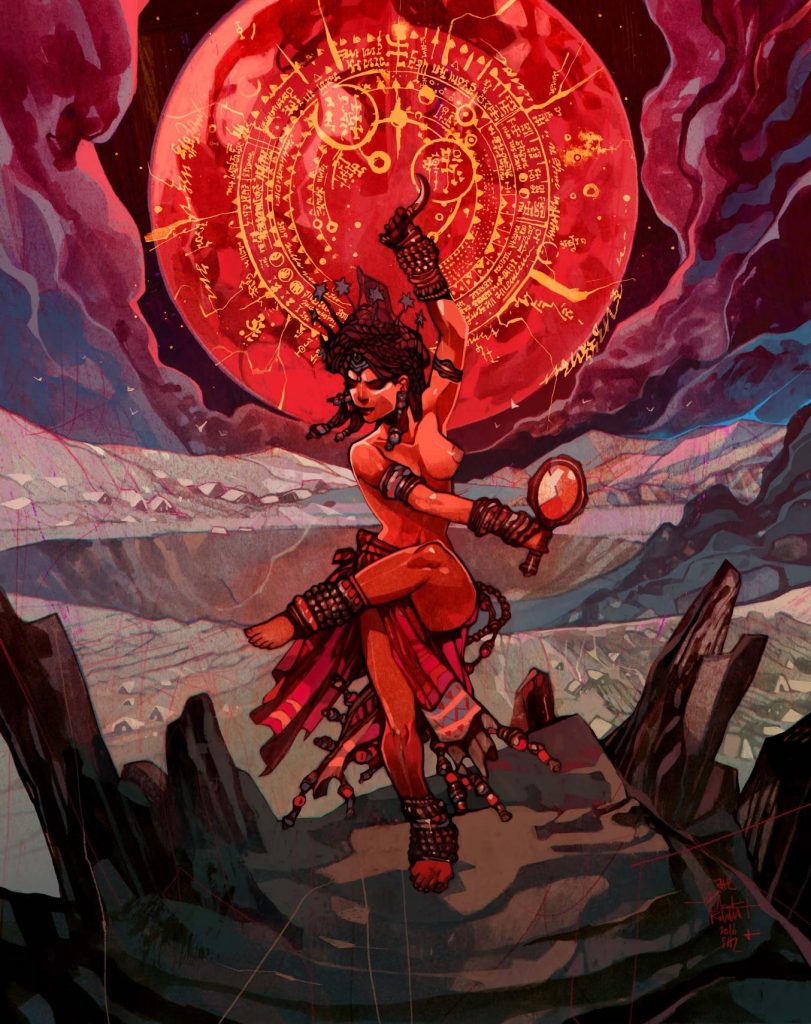
It requires a mystical Illumination to get it – but that is not an urbane thing (the Red Goddess herself was from a village in the sticks).
Her Myth-Self does not properly sit with how the God Learners theorised how the God Time functions. It slices through it at a right angle like Pluto’s orbit.
This is important, pay attention!
This is fantastically disturbing to anyone who is not Illuminated. Most Lunar apologists and scribes don’t get this either – being unilluminated themselves. And so they rely on the tropes of “superior knowledge”, “secret wisdom”, “more civilized”, and “world-conquering empire” – much to the disgust of actual Red Goddess Illuminates.
There’s a reason that the bulk of the Lunar religion consists of more practical and prosaic cults like the Seven Mothers, Hon-eel, and Hwarin Dalthippa. You can get to the Red Goddess from there, but the path is difficult and arduous – but that is fine you don’t have to!
From the outside, almost everybody, from the Malkioni to the Orlanthi and the Uz and the Praxians, just see it all as “embracing Chaos”:
All of these religions conclude that the Red Goddess used Chaos to achieve Goddesshood and that her presence between Time and the God Time threatens the cosmos.
Boldhome Lunar Treasury
During the occupation, Jeff tells us that Boldhome was the administrative centre for the Lunar occupation. The Temple of the Reaching Moon (destroyed during the Dragonrise) was only to be the magical and religious centre. Figuring out how the Sartarite province worked is important to know about the financial state of the realm after the Lunars were defeated.
The Provincial Governor of Dragon Pass (Euglyptus, Fazzur, and Tatius) served as the Red Emperor’s proxy in that province, and was overseen by the Provincial Overseer. The provincial governor combined military, religious, and civil functions and was assisted by personal staff. The primary responsibility of the Provincial Governor was to secure and expand Lunar power in Dragon Pass and beyond.
This Provincial Governor was expected to keep their province independent enough though tax collection and tolls, for instance. This was used to pay the roughly 15,000 Lunar soliders in Dragon Pass (circa 1625), and for building the Temple of the Reaching Moon in the first place (at 10 hectares, it was “about the same size as the Upper City of Jonstown“).
This meant that not only was the Provincial Governor collecting money from merchants, tribal leaders, temples, cities, etc., but was receiving regular infusions of silver from Glamour. Several treasuries were set up. The first was in Boldhome. In 1622, construction of the Temple of the Reaching Moon had progressed far enough that a second treasury was established there. A third treasury was established in New Pavis, for the Lunar Prax province. These treasuries stored silver, minted coins, and a small army of scribes tracked receipts and expenditures.
The treasury in the Temple of the Reaching Moon was lost in the Dragonrise, although it may have fallen into the chasm left behind by the dragon, if your players are adventurous… or very greedy… But both the Boldhome treasury and New Pavis treasury were well stocked when Kallyr Starbrow and Argrath respectively reconquered those cities in 1624 and 1625. They suddenly were sitting on a whole pike of Lunar money! So it’s with that money that Kallyr funded her Lightbringers’ Quest in 1626… that might have jinxed it…
In the mix, Jeff even gives a good world-building tip:
And this is a question I ponder any time I write about a temple complex or a magnificent city structure – who built it and how were they paid? Same thing with armies – how are they fed and how are they paid. Sometimes the answer is a cheat – who built Boldhome? The dwarves! How were they paid? Only Sartar knows! But even that “cheat” explains a lot.
The Temple of the Reaching Moon
Speaking of the Lunar temples, Jeff shared a sketch by Greg Stafford of a “typical” Temple of the Reaching Moon!
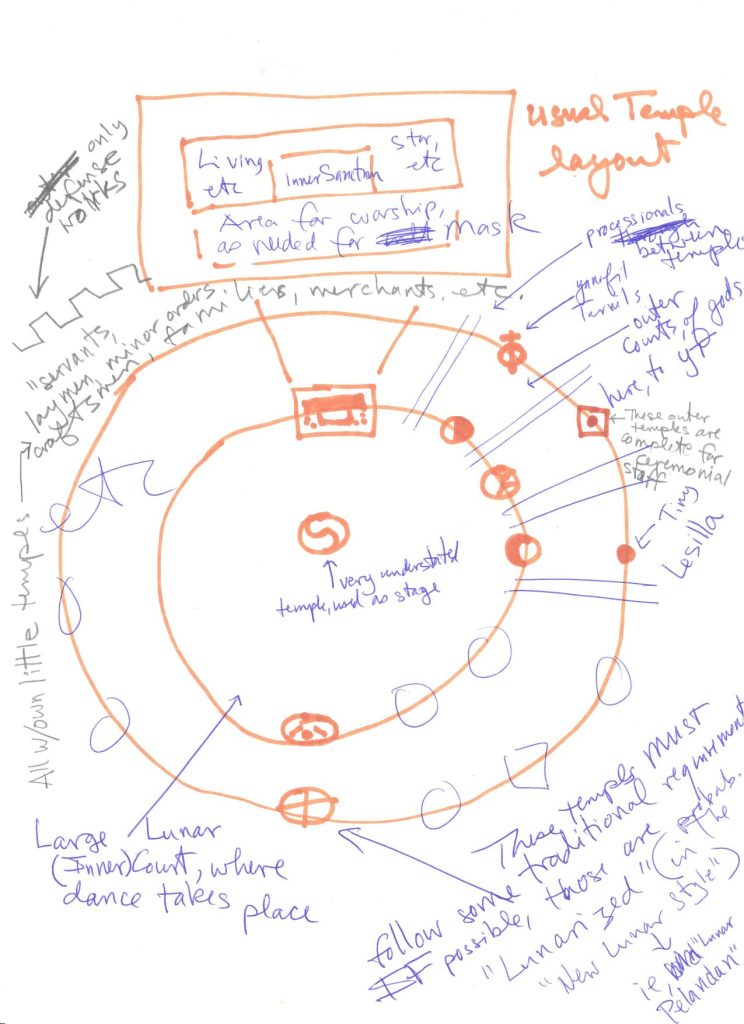
The top box is an enlarged view of the northern and largest temple. The complex is centered on an Inner Court, which is surrounded by numerous temples to the Lunar deities. Beyond that is the Outer court of the gods. Processional ways form axis from the Inner Court. Yara Aranis lives here, guards the temple, and anchors her webs at each temple, thereby expanding the Glowline.
Jeff suggests that we look at the mortuary temple to Hatshepshut (a Pharaoh in the 15th century BCE) for a good reference. The picture below shows the main part of the temple:
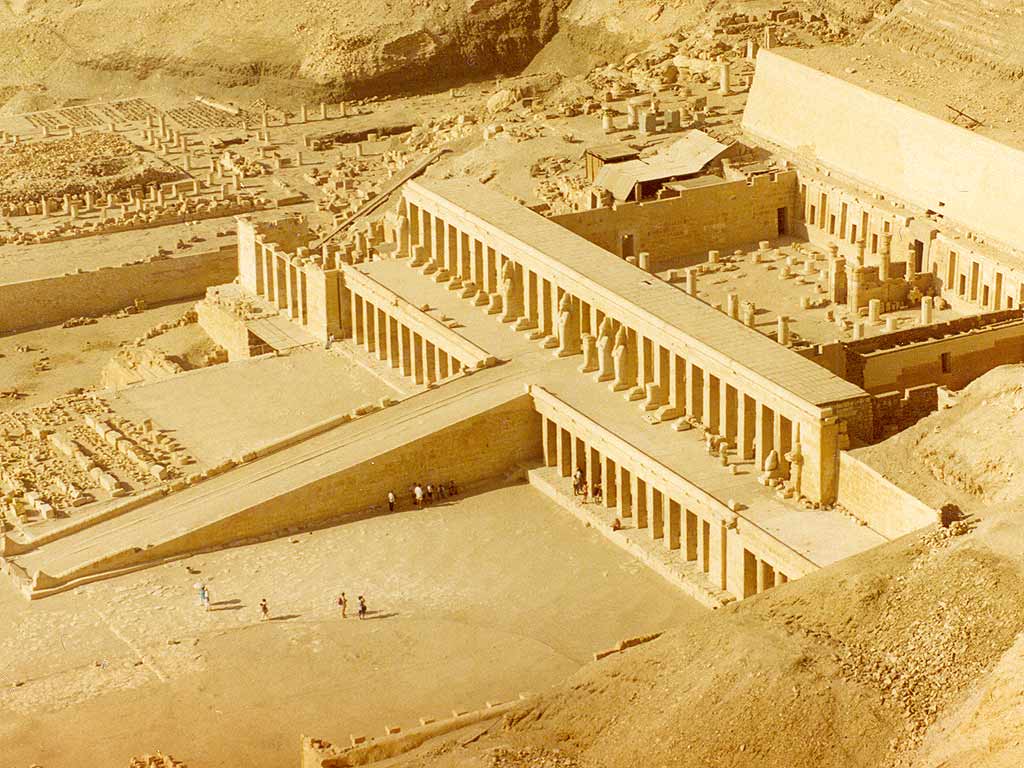
The Kheldon Tribe
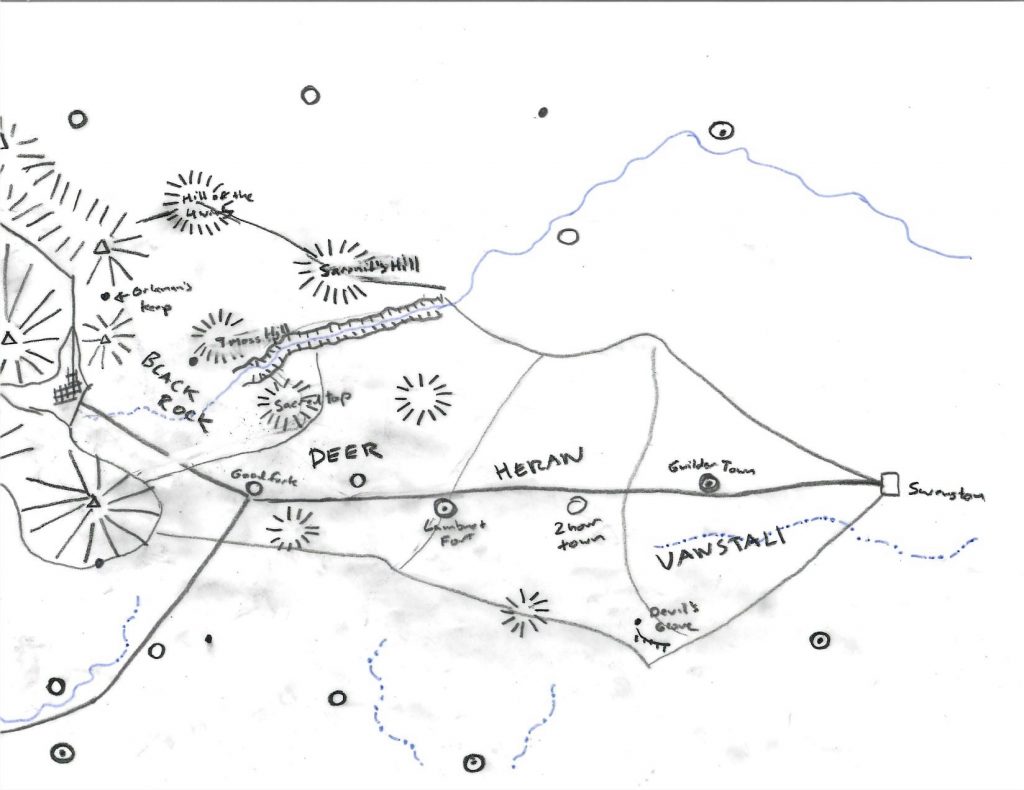
You might know the Kheldon tribe from its most famous king, the rebel leader Kallyr Starbrow. Jeff has some notes about the tribe:
The Kheldon or “Red-Haired” tribe came into Dragon Pass circa 1400, as part of the Second Wave of settlement. They were led by the Red Haired Women and settled in the Killard Vale, the sacred valley where the demigod Heort was born. They were originally called the Black Rock clan and got their name from a black stone that Orlanth hurled from the heavens and gave to the Red Haired Women as a weapon.
Huh, the Vingans have some big black rock they can throw at people to crush them? Sounds like someone should make a new Rune Spell… anyway, Jeff imagines the Killard Vale a bit like Estes Park in Colorado:
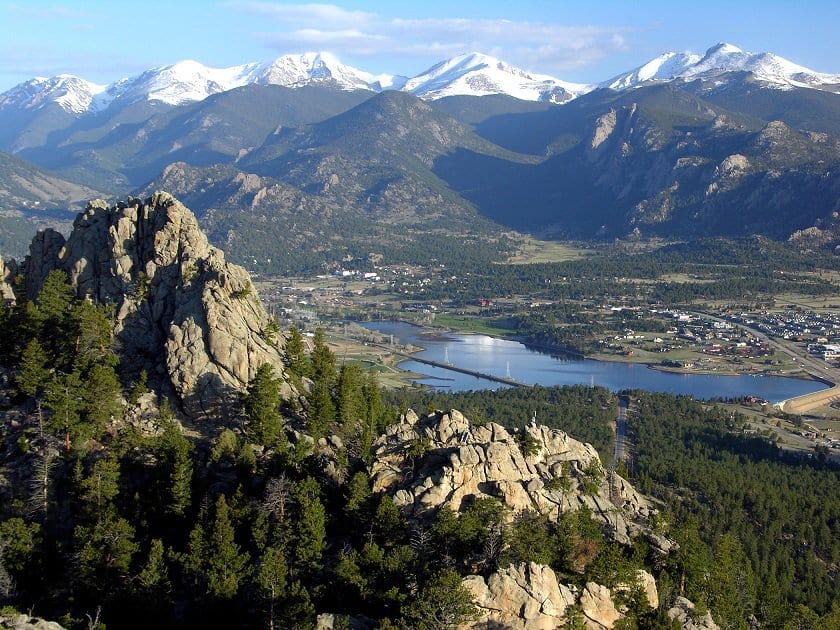
The clans are Black Rock clan (“led by the Vinga cult and its Red-Haired women“), Deer clan, Vanstali clan, and Heran clan.
The write-ups for the clans and tribe continue to use the new “format”, i.e. about a third of children, counting of free and non-free adults separately, listing major, minor, and shrine temples, and so on. This is incredibly useful for Gamemasters to bring an area to life. I especially like the inclusion of notable spirit cults of each region in those write-ups. I don’t know if these spirits will be detailed in the Sartar Homeland books, but the names are evocative enough to bring all kinds of things to mind already. For instance, the Kheldon tribe’s notable spirit cults are Crow, Golden Lamb, Quivin, Silver Deer, and Wilms.
The Culbrea Tribe
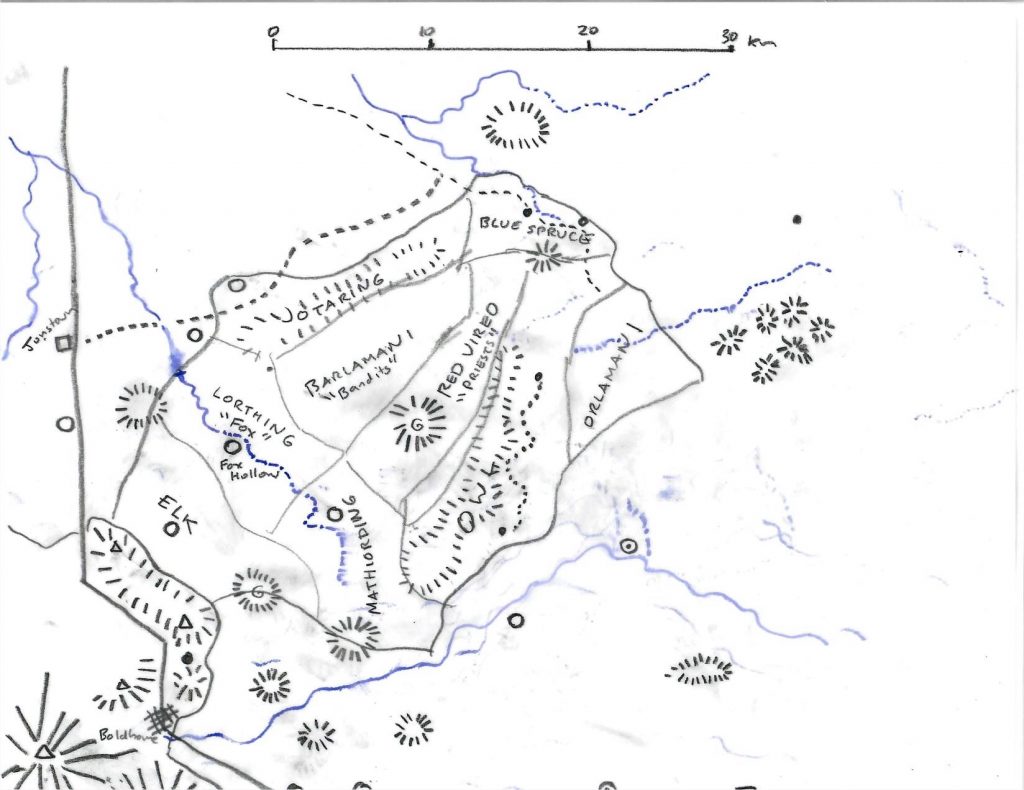
Another tribal write-up preview, this time concerning the Culbrea tribe. The clans are the Elk Clan, Blue Spruce clan (led by Elmalandti, Kallyr’s Orlanth Thunderous priest), Barlamani (lef by King Ranulf), Lorthing, Mathiording, Orlamani, Owl clan, Red Vireo, and Jotarin (a.k.a. Two Pine clan).
A lot of these clans are pretty small, between 300 and 500 people each for most of them. Jeff explains it so:
Several of them are less than a decade old and are likely little more than warrior-initiatory societies than have been living in the hills and raiding like Orlanth Adventurous.
The Barlamani came out of the Lorthing, the Blue Spruce came out of the Mathiording and Red Vireo clans, and the Orlmanni came out of the Owl clan.
These clans are therefore basically a bunch of bandits:
The Culbrea are best known for their control of the Hill of Orlanth Victorious, an important Orlanthi sacred place. The Culbrea are centered on the Lorthing and Moaning Vales. They are a comparatively small and poor tribe, but have more warrior societies than other tribes. The tribe receives much of its revenue from its control over several important sacred places and through war and brigandage. They consider themselves the “Free Tribe” but others call them the “Bandit Tribe.”
A couple clans are redeeming the rest of the bunch, being mostly farmers or pastorialists. My guess is that you want to stay in the valley when you cross their lands…
The recent history of the Culbrea is well known to anybody how has played or read through the HeroQuest Glorantha material:
For some 70 years, the Culbrea were led by Hofstaring Treeleaper, a heroic figure with a magical leaping ability and a spear that could fight on its own. He reluctantly led the tribe in the rebellion later called Starbrow’s Rebellion, and was killed by the Lunars. In punishment for their role in Starbrow’s Rebellion, the Culbrea lost two clans to the Cinsina tribe, and one clan to the Aranwyth. A fourth clan went to the Aranwyth after a short war. The current king, Ranulf, led the tribe to successfully rebel against the Lunar Occupation. During the rebellion, several warrior societies formed into small clans, who survived in the hills through war and banditry.
This shows how the Lunar Occupation can change the make-up of Sartarite tribes, and that in a post-1625 Dragon Pass, you should feel free to change a few things on the map to keep your players on their toes!
Community Roundup
The community roundup is our highlight of interesting things being mentioned in the Glorantha-related Facebook groups, sub-Reddits, and other similar online places.
The Glass Cannon’s Starter Set Finale
This is part 3 of the Glass Cannon’s playthrough of one of the adventures in the RuneQuest Starter Set! Scorpionmen and other Chaos creatures, criticals and fumbles, augments and magic spells, this is RuneQuest alright.
RuneQuest is Complicated
Watching an entire group of newbies take on RuneQuest like this reinforces my thinking that Chaosium should do a big simplification and unification pass on the rules, the way they did for Call of Cthulhu 7th edition — the most popular edition of Call of Cthulhu and BRP by far, by the way.
As far as I can tell, Chaosium’s opinion that “newbies do fine with RuneQuest” is biased by the fact that it’s often an experienced RuneQuest gamemaster leading the game (either one of Chaosium’s own employees, or some long time members of the Cult of Chaos). Watching Troy struggle with system doubt, and seeing players misunderstanding rules reminds me of how I myself struggled with RuneQuest’s rules at the beginning.
Anecdotally, it’s not uncommon to see posts on social media where people hesitate to run RuneQuest despite their curiosity about Glorantha, or people who crashed and burned after their first RuneQuest session and hesitate to pick it up again. As far as I can tell, RuneQuest’s rules are as much an obstacle to playing in Glorantha than it is the intimidating amount of lore.
Well, that’s my hot take of the week anyway. You know where to find me!
Andrew Logan Montgomery Reviews the Starter Set
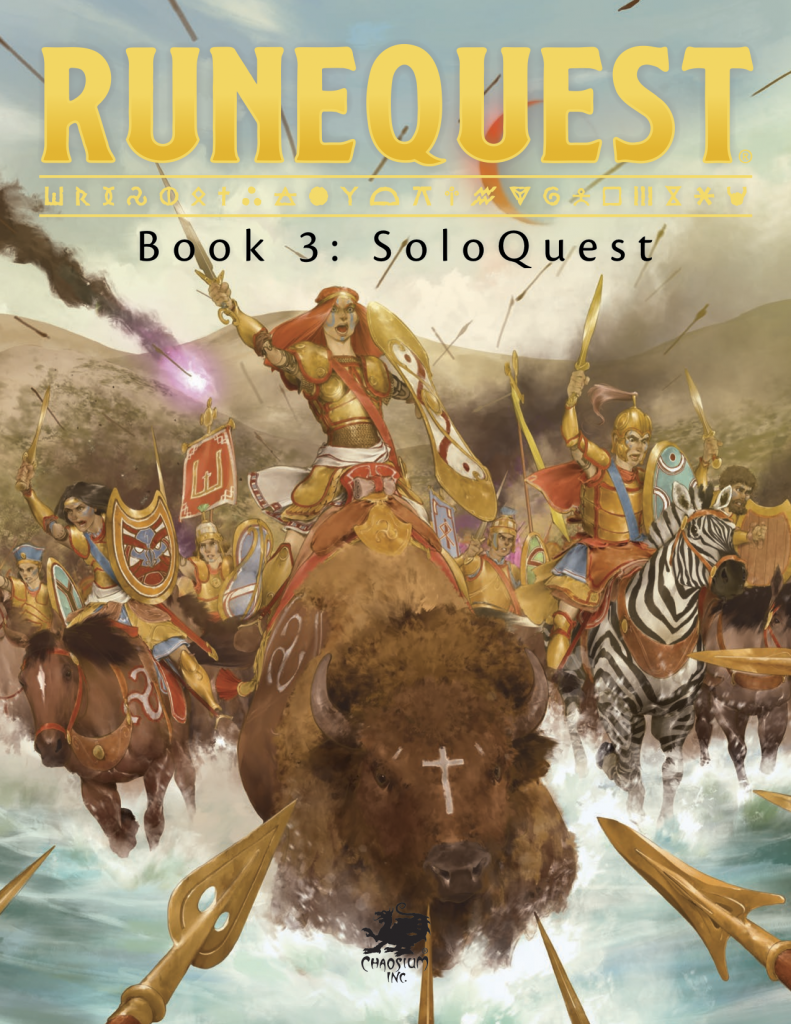
Well, speaking of new Gamemasters having trouble getting started with RuneQuest, Andrew Logan Montgomery (author of Six Seasons in Sartar and The Company of the Dragon, among other things) reviews the RuneQuest Starter Set on his blog, stating that it is indeed the solution:
If only there were a single, streamlined product we could point new players to, a concise entry point that explained the rules, introduced the setting, and made it all effortless to learn and play. Something that showcased what makes this fantasy RPG unique.
Oh wait, now there is…
Andrew then goes on to detail what exactly we find in the box, with the occasional nugget of clarity I’ve come to love from his writings:
Over the last four decades art for Glorantha has been all over the place, something curiously at odds with a game that has such well defined cultures. There has been a real effort in the Runequest line since 2018 to be consistent in the depiction of these cultures, and to make them look unique (as opposed to, say, just fantasy Greeks or Celts or Vikings).
Anyway, read the rest of the review if you’re curious about the Starter Set — it’s an excellent overview.
Skull Dixon’s Review of The Smoking Ruin
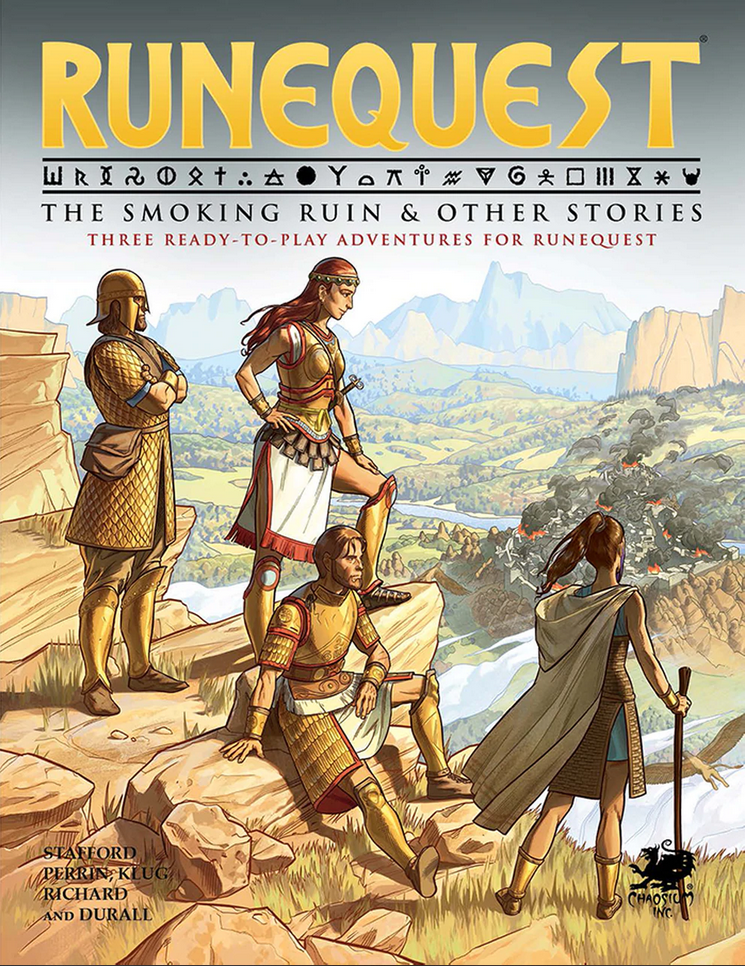
If you’re on the fence about buying or playing Chaosium’s first adventure book for the latest RuneQuest edition, Skull Dixon has a comprehensive review for you. More than a review, it’s also an in-depth look at the adventure, with some advice to deal with some of the difficult bits. This general comment in the article’s intro echoes a criticism I’ve heard a few times about the titular scenario:
As much as I like this adventure, I found this one particularly difficult to run. I read the adventure more than I normally read through any adventure. At the most, I normally read through an adventure twice. I read through The Smoking Ruinsadventure four times and did some additional skimming before each game session to remind myself of key info for that week’s session. I’m a minimalistic GM when it comes to prep, so it was very much outside my comfort zone to reread this adventure this many times.
Thankfully, Skull Dixon breaks it down for you, which may come in handy when you decide to run The Smoking Ruin. In particular, check the last section of the review, with suggested changes or additions to the adventure. If you’ve read the author’s previous adventure reviews, you should be familiar with those, and how useful they can be.
More Ducks!
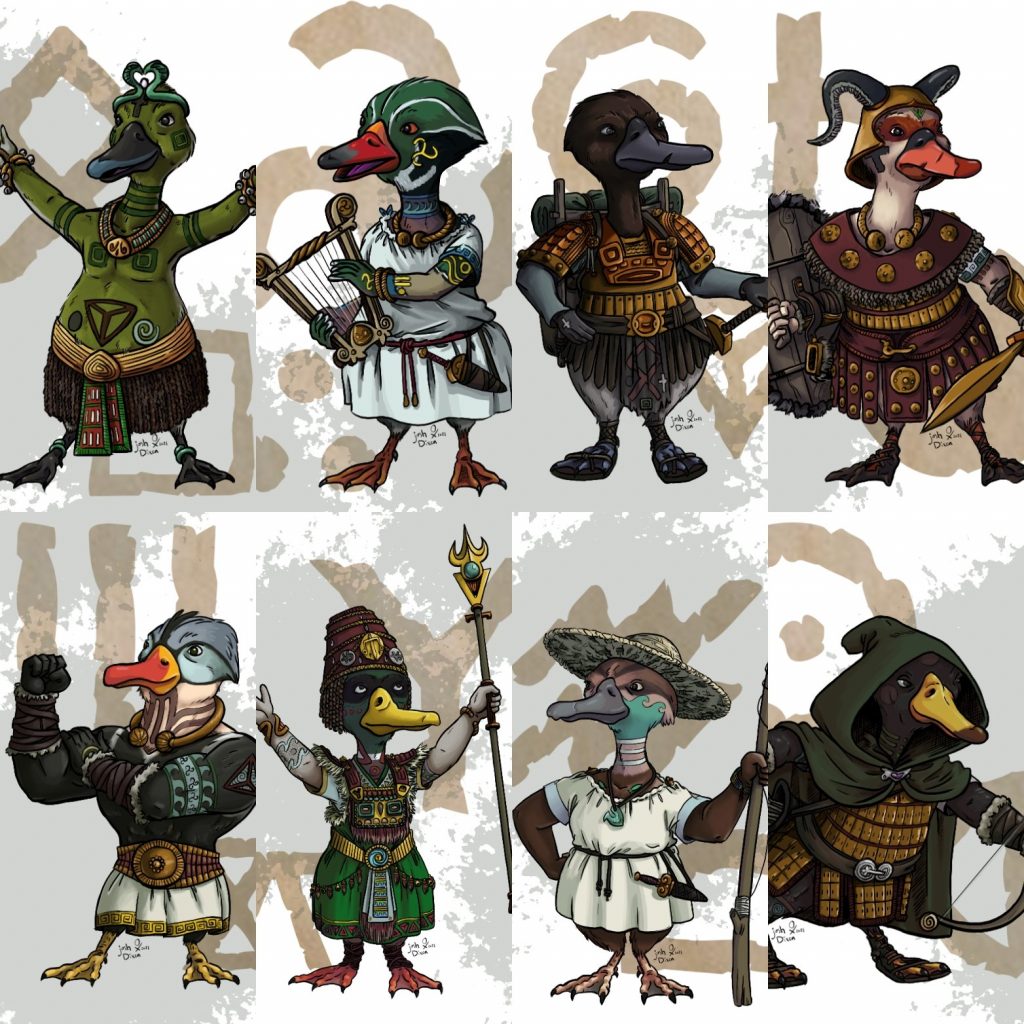
Speaking of Skull Dixon, you might remember that he was drawing some cool Gloranthan ducks a couple weeks ago. Well, apparently it’s so fun he kept going!
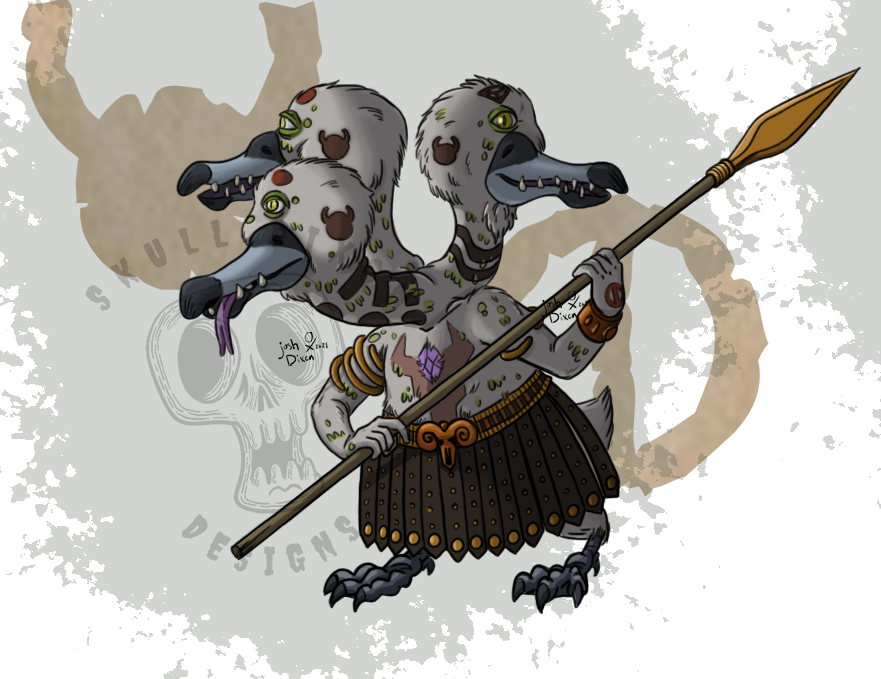
You can find all of his illustrations so far on his Behance portfolio, including the awesome Chaotic Duck seen above. He (Skull Dixon, not the duck) suggested that these drawings might get collected one day for a Jonstown Compendium thing…
Exploring Glorantha Episode 11: The Chaos Pantheon
Evan and JM are joined by Becca, a regular on the Thirteenth Age Iconic Podcast, to present and discuss some of the most important cults and monsters of Chaos in Glorantha. You may want to be warned that the hosts are using RQ3’s more “gruesome” (or “cringy”, depending on your take) write-ups for some of these Cults of Terror (for instance, Thed’s myth doesn’t include rape in the original RQ2). This is all handled and discussed with tact as far as I can tell (including some interesting anecdote about introducing Broos to male and female players), but there’s a reason why Evan and JM flagged the video as “mature”, so consider this a content warning.
The video comes, as always, with a very handy list of time stamps that allow you to jump to a specific cult or creature.
Elsewhere on Arachne Solara’s Web
Not everything is about Glorantha, although most things are! Here are loosely relevant things that we found on the interwebs.
Don’t Offend the Sky Gods

It looks like historians now think that the city of Tall el-Hammam, a Bronze Age city in the Southern Jordan Valley, was destroyed by a “cosmic air burst”. That is: a meteor exploded in the skies above upon atmospheric entry, and that sent an air burst powerful enough to flatten entire buildings.
The proposed airburst was larger than the 1908 explosion over Tunguska, Russia, where a ~ 50-m-wide bolide detonated with ~ 1000× more energy than the Hiroshima atomic bomb. A city-wide ~ 1.5-m-thick carbon-and-ash-rich destruction layer contains peak concentrations of shocked quartz (~ 5–10 GPa); melted pottery and mudbricks; diamond-like carbon; soot; Fe- and Si-rich spherules; CaCO3 spherules from melted plaster; and melted platinum, iridium, nickel, gold, silver, zircon, chromite, and quartz. Heating experiments indicate temperatures exceeded 2000 °C.
The most famous meteor air burst you may have heard about was the Tunguska event, which featured a 12 megaton explosion. I’ll let y’all debate whether this is caused by Lunar sorcery (meteors!), Yelmic intervention (explosions in the sky!), or so Orlanthi shenanigans (there is no meteor, just a big ass air burst!).
Thanks to Martin Heldson for the link!
Thank you for reading
That’s it for this week! Please contact us with any feedback, question, or news item we’ve missed!


